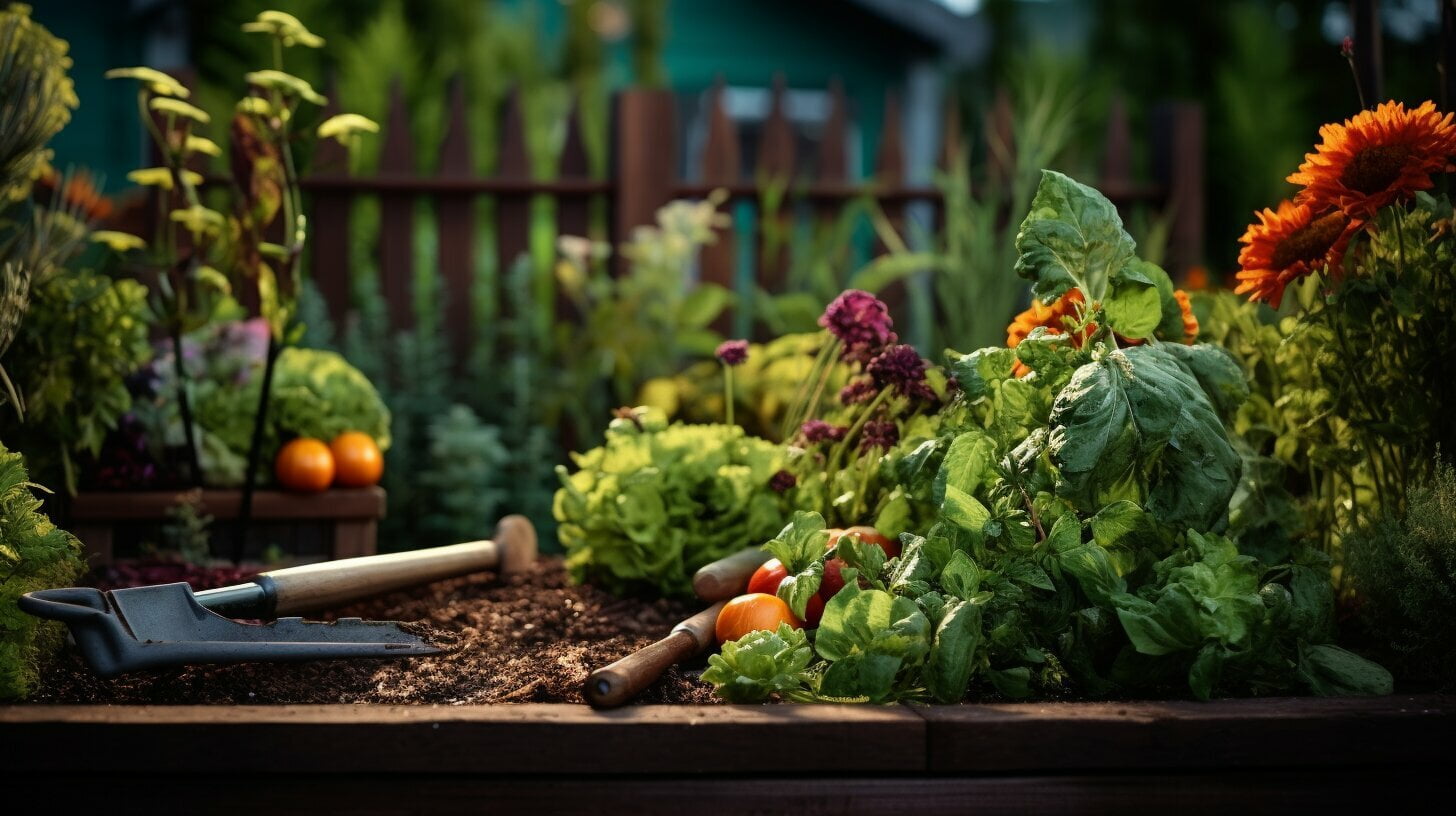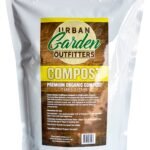Welcome to the wonderful world of organic raised bed gardening! Here, we believe that anyone can create a thriving vegetable garden right in their own backyard. By utilizing sustainable gardening practices, we can promote a healthier environment for ourselves and future generations.
Organic raised bed gardening is a rewarding way to grow your own food, improve soil health, and connect with nature.
In this comprehensive guide, we will explore the benefits of organic raised bed gardening and provide you with all the information you need to get started. From constructing your raised bed to nurturing the soil food web, we’ve got you covered.
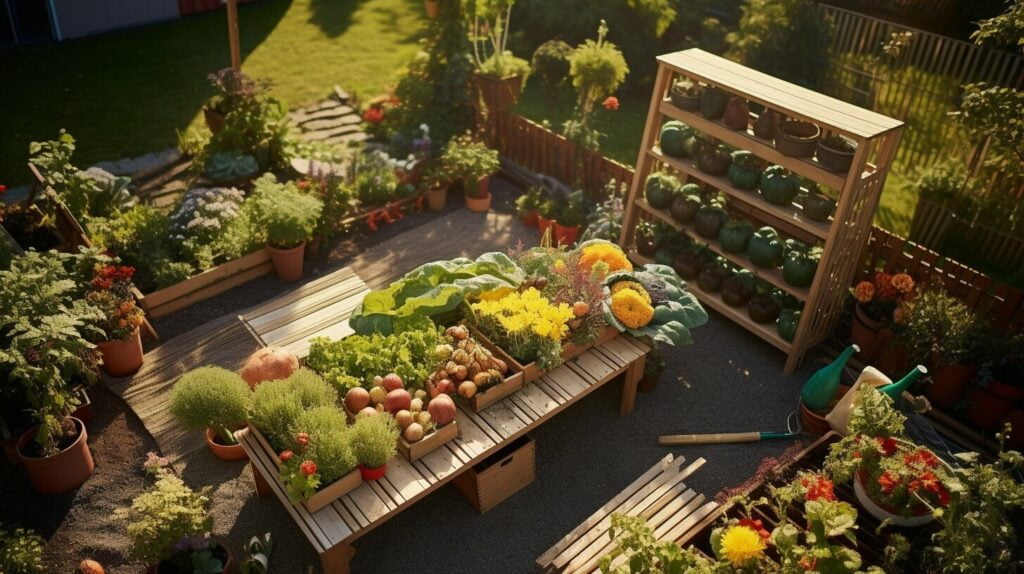
Key Takeaways for Better Organic Raised Bed Soil:
- Organic raised bed gardening is a sustainable way to grow your own food
- Raised beds can improve soil health and productivity
- Choosing the right soil and amendments is crucial for optimal plant growth
- The soil food web plays an important role in plant nutrition and should be nurtured
- Maximizing yields with organic techniques can increase your garden’s productivity
Understanding the Basics of Raised Garden Bed
At some point in our lives, we’ve all dreamed of having a beautiful vegetable garden right in our backyard. However, it can be challenging to achieve a thriving garden without the right conditions. That’s where raised bed gardening comes in.
Raised beds are essentially garden beds that are elevated above ground level, typically framed with wood, brick, or stone. They offer several advantages over traditional gardening in the ground, including better drainage, increased soil quality, and reduced weed growth.
Read More OutdoorGoodness Articles:
One of the primary benefits of a raised garden bed is that it allows more control over the growing conditions, making it easier to create a healthy environment for your plants. You can customize the soil mix, adjust moisture levels, and even add beneficial amendments. All of these factors, along with the extra height, lead to a more efficient and productive vegetable garden.
Whether you’re a seasoned gardener or a first-timer, a raised bed garden can be an excellent addition to your backyard. With a little planning and attention to detail, you can create a beautiful and bountiful vegetable garden that you’ll be proud to call your own.
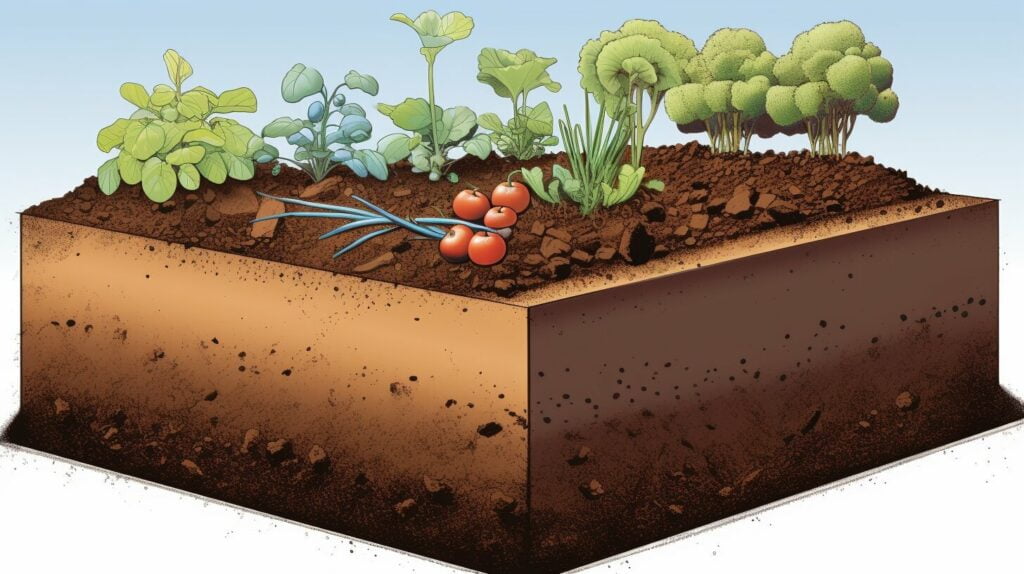
Choosing the Right Soil for Your Raised Bed Vegetable Garden
When it comes to organic raised bed gardening, choosing the right soil is crucial to the success of your garden. The quality of your soil will play a significant role in the health and productivity of your plants.
There are numerous options available for raised bed soil, including pre-made mixes from your local garden center or creating your own organic raised garden bed soil recipe.
If you opt for creating your own soil mix, start with a base of garden soil or native soil from your yard. This will provide a foundation of nutrients and minerals for your plants. Next, add organic matter such as compost or well-rotted manure to improve soil structure and fertility.
Finally, consider soil amendments such as bone meal, blood meal, and fish emulsion to add additional nutrients and enhance the quality of your soil.

Remember to keep the needs of your soil in mind when filling your new raised bed. Be sure to calculate the amount of soil needed to fill your bed based on its dimensions and the depth you desire.
Building and Filling Compost Soil Volume for Your Raised Bed
Now that we have chosen the perfect soil for our organic raised bed garden, it’s time to build and fill our wood raised bed. Let’s get started!
Step 1: Constructing Your Raised Bed
An epic gardening project, building your raised bed structure can be as simple or as elaborate as you choose. For a basic raised bed, you can use wood planks to create a rectangular frame of your desired size. If you prefer a sturdier option, consider using cinder blocks or bricks. Using concrete blocks for a raised bed makes it sturdy indeed. When constructing your raised bed, make sure it is level and sturdy.

Step 2: Filling Your Raised Garden Bed
Before adding your raised bed soil recipe, it’s essential to create a barrier at the bottom of the bed to prevent weeds and grass from growing up through the soil. You can use a layer of cardboard or newspaper to provide this barrier.
Next, fill your bed with your chosen bags of garden soil mix, whether it’s a bagged soil mix or a custom-made blend. Make sure to fill the bed mix to the top, leaving a flat and even surface for great soil mixture. Note: there are raised bed kits for sale.
Step 3: Adding Compost
Adding soil or compost to your raised bed is a great way to improve soil fertility and promote healthy plant growth. You can make your own compost or purchase it from a local garden center. To add compost, spread a layer over the top of your soil in your bed and gently mix it in.
Step 4: Choosing Your Plants
Now that your raised bed is built and filled with soil and compost, it’s time to choose your plants. When selecting plants, consider the size of your bed, the amount of sunlight it receives, and the type of soil you have. Some plants work well in raised beds, such as lettuce, tomatoes, and peppers. Choose plants that will thrive in your raised bed garden.
Step 5: Watering Your Raised Bed
Watering is essential for the health of your raised bed garden. After planting, make sure to water your bed to settle the soil and stimulate root growth. Be mindful not to overwater, as this can lead to issues like root rot. Check your bed regularly to ensure it has adequate moisture.
With these simple steps, we can now enjoy our new organic raised bed garden. By filling our bed with quality soil and compost, we have set ourselves up for a bountiful harvest. Let’s fill our beds with the plants of our choice and watch them grow!
Nurturing the Soil Food Web
At the heart of organic raised bed gardening lies the health and vitality of the soil food web. By nurturing this complex system of microscopic organisms, we can produce healthy, nutrient-rich soil that supports optimal plant growth and health.
One of the most important ways to support the soil food web is by adding organic matter to your soil that is rich in organic matter. This can include compost, leaf mold, and other plant debris that breaks down into rich, fertile soil over time. By incorporating organic matter into your raised bed garden, you can improve structure, increase water retention, and promote the growth of beneficial soil microorganisms.
Another essential component of soil health is organic fertilizer. Unlike synthetic fertilizers, which can harm the soil food web and lead to nutrient imbalances, fertilizers like bone meal, blood meal, and fish emulsion, added to the soil, are derived from natural sources and provide a balanced mix of nutrients to support plant growth.
The soil food web itself is made up of a complex network of organisms, including bacteria, fungi, protozoa, and nematodes. These organisms work together to break down organic matter, release nutrients, and improve structure. By creating a thriving soil food web in your raised bed garden, you can ensure that your plants have access to all the nutrients they need to grow strong and healthy.
To encourage the growth of beneficial soil organisms, it’s important to avoid the use of synthetic pesticides and herbicides, which can harm the soil food web and disrupt the delicate balance of the ecosystem. Instead, focus on creating a healthy, balanced environment for your plants and the organisms that support them.
Building a thriving soil food web takes time and patience, but the rewards are well worth the effort. By nurturing the complex system of microorganisms that make up your soil, you can create a healthy, sustainable raised bed garden that provides bountiful harvests and promotes a healthier environment for us all.

Maintaining a Healthy Raised Bed Garden
As we continue our organic raised bed gardening journey, we must strive to maintain the health and fertility of our soil. By doing so, we ensure that our plants receive the nutrients they need to flourish.
The first step in maintaining a healthy raised bed garden is to assess the soil surface. Is it compacted or loose? Does it contain an adequate amount of organic matter? These questions are crucial in determining the soil needs of your garden.
Soil quality is another important factor in promoting healthy plant growth. The structure of the soil affects its ability to retain water and nutrients. By maintaining a loose, crumbly soil structure, we encourage root growth and improve soil health.
It’s also essential to monitor the soil pH and adjust it as needed. Different plants require different pH levels to grow optimally. By testing the soil ph and making adjustments, we can ensure that our plants receive the pH environment they need to thrive.
Remember, the health of the soil and the health of the plant are interdependent. As we care for the soil, we care for the plant.
Therefore, it is crucial to keep an eye on both the soil and the plant. Do the plants look healthy, or are they showing signs of nutrient deficiencies? Do they have the space they need to grow, or do they look cramped? As gardeners, we must observe and respond to the needs of our plant soil.
By promoting soil health, we promote the health of our plants, and vice versa. By nurturing the relationship between soil and plant, we create a thriving ecosystem that benefits us all.

Let’s continue to nurture our soil and our plants, ensuring that our raised bed gardens flourish. Together, we can create a sustainable and healthy garden ecosystem that we can be proud of.
Maximizing Yields with Organic Techniques
One of the great benefits of organic raised bed gardening is the ability to maximize yields and increase plant vitality through various organic techniques. By using these techniques, we can achieve a thriving garden that produces healthy and delicious vegetables all season long.
One important consideration when using organic techniques is the type of soil in your raised beds. If you are starting with native soil or existing soil, it’s important to amend it with organic matter and other nutrients before planting. The soil in your raised bed should be a high-quality organic raised bed garden soil that is designed specifically for raised bed gardening. This will ensure that your plants have the proper drainage, nutrients, and structure they need to thrive.
Another technique for maximizing yields is companion planting. This involves planting certain crops together that benefit each other in some way. For example, planting basil alongside tomatoes can enhance the flavor of both plants, while planting marigolds can help repel pests and attract beneficial insects.
Crop rotation is another important technique for maintaining soil health and maximizing yields. This involves rotating crops from year to year to prevent soil-borne diseases and pests from building up in the soil. For example, if you planted tomatoes in one raised bed last year, you should plant a different crop in that bed this year to prevent soil-borne diseases from affecting your tomatoes.
Succession planting is another organic technique that can help maximize yields. This involves planting crops in stages so that you can harvest vegetables throughout the season rather than all at once. For example, you could plant one row of lettuce in April, another row in May, and a third row in June, so that you have fresh lettuce all season long.
By using these organic techniques in your raised bed garden, you can maximize yields and promote a healthy, sustainable ecosystem in your backyard. Remember to use high-quality organic raised bed soil and take good care of your plants, and you’ll be sure to enjoy a bountiful harvest all season long.
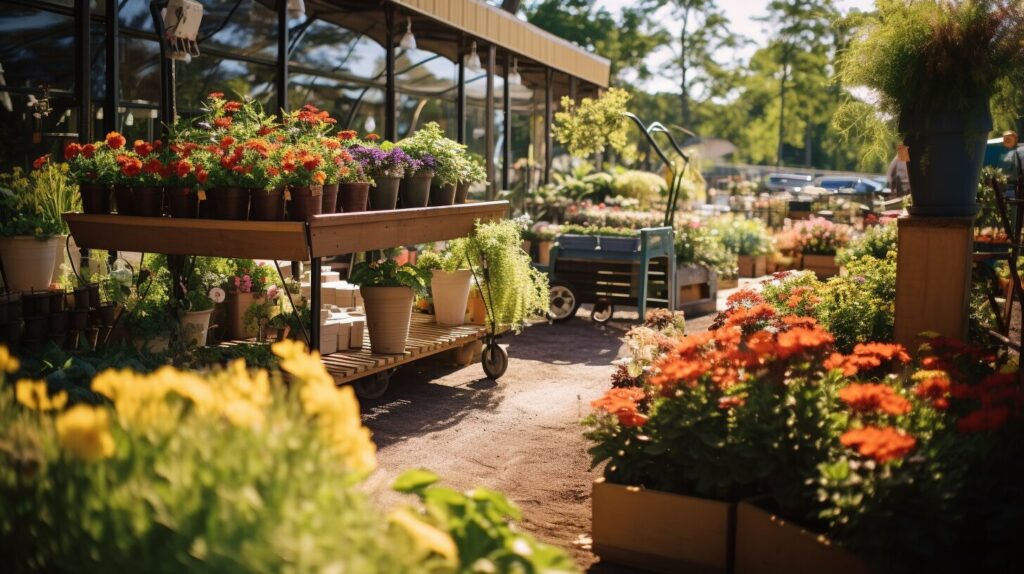
Sourcing Organic Materials and Resources
As we strive to create a healthy and sustainable organic raised bed garden, it’s important to source the right materials and resources. One of the best places to start is your local garden center. Here, you can find a variety of organic soil mixes, compost, and fertilizers that are suitable for raised bed gardening. Plus, you can get expert advice from the staff on which products will work best for your specific needs.
If you don’t have a nearby garden center, consider looking for local farms and nurseries that offer organic products. These sources often have specially crafted soil blends and compost that can support healthy plant growth and soil health.
Another option is to create your own soil mix using locally sourced materials. This allows you to have complete control over the ingredients and ensure that they are truly organic. You can use materials such as compost, vermiculite, coir, and perlite to create a custom soil mix tailored to your garden’s needs.
When sourcing your materials, it’s important to consider the soil food web. Using products that support and enhance the soil food web can help promote healthy soil and plant growth. Look for amendments such as bone meal, blood meal, and fish emulsion that can provide the nutrients needed to create a thriving ecosystem in your garden.
By sourcing materials and resources that are organic, we can create a truly sustainable and thriving organic raised bed garden. Let’s support our local garden centers and farms and embrace the beauty of organic gardening.
Conclusion
Let’s take a moment to reflect on the amazing journey we have been on together. We have explored the wonders of organic raised bed gardening and learned how to create a thriving garden ecosystem right in our own backyards.
By understanding the basics of raised bed gardening and choosing the right soil, we have set ourselves up for success. We’ve learned how to build and fill our raised beds and how to nurture the soil food web for optimal plant growth and health.
Maintaining a healthy raised bed garden is key, and we now know how to monitor and adjust soil moisture, ensure proper drainage, address pH imbalances, and prevent nutrient deficiencies. We have even discovered organic techniques to maximize yields and increase plant vitality.
But our journey doesn’t end here. Sourcing materials and resources is essential, and we have learned where to find organic soil, compost, fertilizers, and other gardening supplies. By supporting local garden centers and exploring online resources for organic gardening, we can continue to promote a healthier environment for ourselves and future generations.
So let’s roll up our sleeves, grab our tools, and start our organic raised bed gardens today. Together, we can embrace a healthy, sustainable lifestyle and enjoy the rewards of growing our own food.
FAQ
Q: What is organic raised bed gardening?
A: Organic raised bed gardening is a method of growing plants in raised beds using organic and sustainable practices. It involves creating raised planting areas and filling them with nutrient-rich soil, allowing for better drainage and improved plant health.
Q: Why should I choose raised bed gardening?
A: Raised bed gardening offers several advantages. It promotes better soil drainage, prevents soil compaction, and provides easier access for planting, weeding, and harvesting. Raised beds also allow gardeners to more easily control quality, manage pests, and maximize garden space.
Q: How do I choose the right soil for my raised bed?
A: The key to successful organic raised bed gardening is choosing the right soil. Look for a well-balanced organic soil mix or create your own using compost, peat moss, and vermiculite. Consider adding soil amendments such as organic fertilizers and composted manure to improve fertility.
Q: How do I build and fill a raised bed?
A: Building a raised bed is a straightforward process. Start by selecting high-quality materials such as untreated lumber or stone. Construct the bed to your desired dimensions, ensuring it is at least 6-8 inches deep. Fill the bed with your chosen organic soil mix, leaving room for settling.
Q: How can I nurture the soil food web in my raised bed?
A: The soil food web is crucial for healthy plant growth. To nurture it, incorporate organic matter such as compost or worm castings into your soil. Use organic fertilizers to provide essential nutrients, and avoid using chemical pesticides that can harm beneficial soil organisms.
Q: How do I maintain a healthy raised bed garden?
A: Regular maintenance is essential for a healthy raised bed garden. Monitor soil moisture levels and adjust watering accordingly. Ensure proper drainage to prevent waterlogging. Test and adjust pH if needed. Add organic matter and fertilizers to replenish nutrients and support overall soil health.
Q: How can I maximize yields with organic techniques?
A: Organic raised bed gardening offers various techniques to maximize yields. Consider companion planting, which involves growing compatible plants together to enhance growth and deter pests. Rotate crops each season to prevent soil depletion. Practice succession planting to extend your harvest throughout the growing season.
Q: Where can I source organic materials and resources for my raised bed garden?
A: Look for local garden centers and nurseries that offer organic soil mixes, compost, and fertilizers. Supporting these businesses helps promote sustainable gardening practices. You can also find organic gardening supplies online, including seeds, tools, and helpful resources.
Q: How do I get started with organic raised bed gardening?
A: To get started, determine the size and location of your raised bed garden. Choose the right materials for building your bed and fill it with high-quality organic soil. Decide what plants you want to grow and plan your garden layout accordingly. Regularly maintain and nurture your garden to promote optimal plant growth and overall soil health.

Meet Kevin Goodell, your outdoor adventure coach! With a passion for nature ignited in childhood, Kevin brings a wealth of experience and expertise to simplify tough outdoor skills. As a U.S. Army veteran and former Sergeant, he has honed his leadership and teamwork abilities while developing a deep love for the great outdoors.
Kevin’s dedication to outdoor activities spans biking, birdwatching, national park trips, and archery/golf. With his friendly and approachable demeanor, he is committed to guiding individuals of all ages and skill levels towards unforgettable outdoor experiences.
Harnessing his extensive knowledge and personal achievements, Kevin is your go-to resource for learning and enjoying various outdoor pursuits. Whether you seek thrilling adventures or serene nature escapes, Kevin’s professional yet friendly approach will ensure an engaging and informative experience. Embark on your next outdoor adventure with Kevin Goodell and embrace the beauty of nature like never before.

